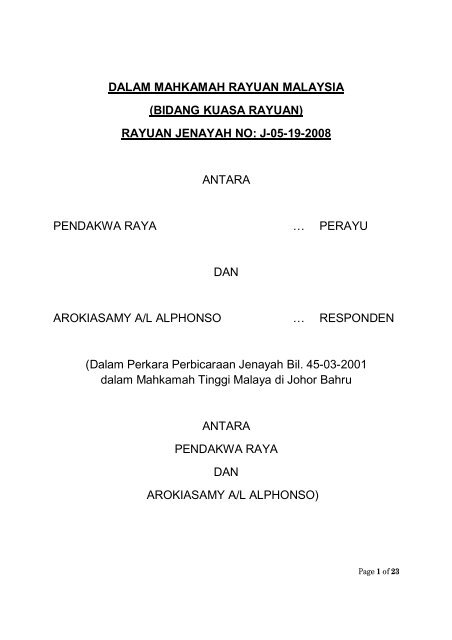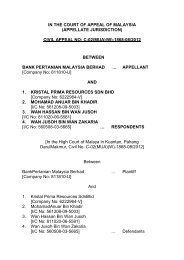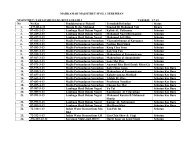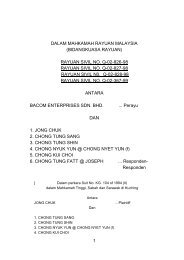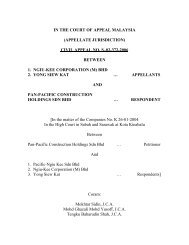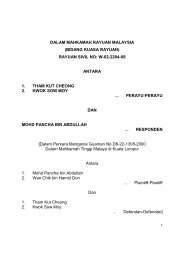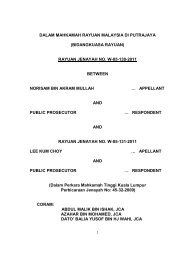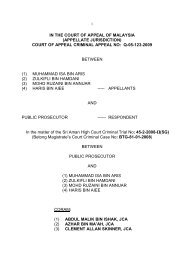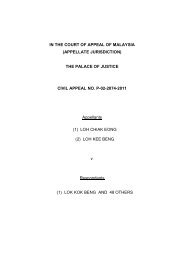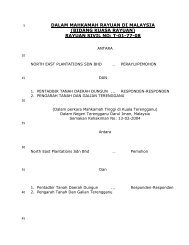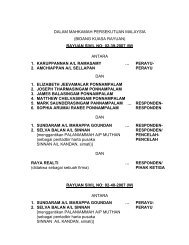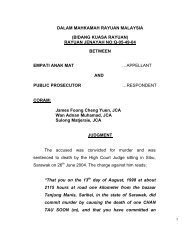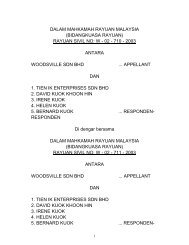(bidang kuasa rayuan) rayuan jenayah no: j-05-19-2008 antara ...
(bidang kuasa rayuan) rayuan jenayah no: j-05-19-2008 antara ...
(bidang kuasa rayuan) rayuan jenayah no: j-05-19-2008 antara ...
You also want an ePaper? Increase the reach of your titles
YUMPU automatically turns print PDFs into web optimized ePapers that Google loves.
DALAM MAHKAMAH RAYUAN MALAYSIA<br />
(BIDANG KUASA RAYUAN)<br />
RAYUAN JENAYAH NO: J-<strong>05</strong>-<strong>19</strong>-<strong>2008</strong><br />
ANTARA<br />
PENDAKWA RAYA … PERAYU<br />
DAN<br />
AROKIASAMY A/L ALPHONSO … RESPONDEN<br />
(Dalam Perkara Perbicaraan Jenayah Bil. 45-03-2001<br />
dalam Mahkamah Tinggi Malaya di Johor Bahru<br />
ANTARA<br />
PENDAKWA RAYA<br />
DAN<br />
AROKIASAMY A/L ALPHONSO)<br />
Page 1 of 23
CORAM: HASAN LAH, JCA<br />
MALIK ISHAK, JCA<br />
SYED AHMAD HELMY SYED AHMAD, JCA<br />
JUDGMENT<br />
[1] The respondent was charged under s. 302 of the Penal<br />
Code for the murder of Ganam a/p Sinnasamy (“the<br />
deceased”). At the conclusion of the trial the learned trial<br />
Judge acquitted the respondent on ground of insanity and<br />
ordered the respondent to be kept in safe custody pending<br />
the order of the Ruler of the State of Johor pursuant to s.<br />
348 of the Criminal Procedure Code.<br />
[2] The Public Prosecutor appealed against the decision. We<br />
heard the appeal and at the close of the hearing we allowed<br />
the Public Prosecutor’s appeal. We found the respondent<br />
guilty of the offence of murder and convicted him for the<br />
offence charged. He was sentenced to death. We <strong>no</strong>w give<br />
our reasons.<br />
[3] The charge against the respondent is as follows:<br />
Page 2 of 23
“Bahawa kamu pada <strong>19</strong> Julai 2000, jam <strong>antara</strong><br />
9.30 malam hingga 11.00 malam di dalam kereta<br />
Proton Tiara No. JEL 7806, di tepi Jalan Berjaya<br />
8, Taman Perindustrian Berjaya, Tampoi, di dalam<br />
daerah Johor Bahru, di dalam Negeri Johor Darul<br />
Ta’zim, telah melakukan kesalahan membunuh<br />
dengan menyebabkan kematian ke atas Ganam<br />
a/p Sinnasamy, No. K/P. 610826-08-5986 dan<br />
oleh yang demikian, kamu telah melakukan satu<br />
kesalahan yang boleh dihukum di bawah seksyen<br />
302 Kanun Keseksaan.”<br />
Case For the Prosecution<br />
[4] The facts of the prosecution case as found by the learned<br />
trial Judge are these. At about 10.30 p.m. on <strong>19</strong>.7.2000 the<br />
respondent went into Inspector Tha Na Sak’s (PW8) office at<br />
the Johor Bahru police station. The respondent’s shirt was<br />
stained with blood and he was shivering. When PW8 asked<br />
him why he was shivering the respondent answered that he<br />
had killed his sister-in-law.<br />
[5] The respondent then led PW8 to a green Proton Tiara car<br />
parked outside PW8’s office. Inside the car, at the front<br />
passenger seat, was the dead body of the deceased. Her<br />
Page 3 of 23
head was leaning onto the side glass window of the said car.<br />
There were slashed mark on her neck and blood stains on<br />
her dress. There was a kitchen knife stained with blood at<br />
the footwell on the driver’s side of the car.<br />
[6] The respondent was arrested by PW8 on the instruction of<br />
the investigating officer, ASP James a/l Jonathan (PW9).<br />
Soon after the respondent brought a police party led by PW9<br />
to Jalan Berjaya 8, Taman Perindustrian Berjaya, Tampoi,<br />
about 10 kilometres from the police station allegedly the<br />
place where he committed the act.<br />
[7] Upon returning to the police station PW8 took possession of<br />
the clothing the respondent was wearing, the knife and the<br />
car which was later ascertained to belong to the respondent.<br />
The blood stain on the knife was later found by the<br />
Government chemist to be of the same group AB, as the<br />
deceased’s, suggesting it was the murder weapon.<br />
[8] The post-mortem on the deceased’s body was conducted on<br />
20.7.2000 by Dr. Shahidan Mohd Noor (PW1). There were<br />
several stab and incised wounds on the deceased’s body.<br />
An incised wound on front lower part of her neck severed the<br />
airway and major vessels there. According to PW1 the<br />
Page 4 of 23
cause of the deceased’s death was due to the incised wound<br />
on the deceased’s neck.<br />
Finding at the close of the case of the prosecution<br />
[9] The learned trial Judge admitted the confession made by the<br />
respondent to PW8 that he killed the deceased as it was<br />
made voluntarily. It is to be <strong>no</strong>ted that during the trial<br />
learned counsel for the respondent conceded that the<br />
confession was made voluntarily without inducement, threat<br />
or promise.<br />
[10] The learned trial Judge held that there are corroborative<br />
evidence to support the respondent’s confession. They are<br />
as follows:<br />
(a) the respondent’s clothing was stained with<br />
blood;<br />
(b) the recovery of the blood-stained knife in the<br />
car; and<br />
(c) the possession of the corpus by the<br />
respondent and its delivery to the police<br />
station.<br />
[11] The learned trial Judge found the multiple stab wounds on<br />
the body of the deceased were indicative of the fact that they<br />
Page 5 of 23
could have been inflicted by the doer with the intention of<br />
causing death.<br />
[12] The learned trial Judge therefore ruled that a prima facie<br />
case had been proved by the prosecution against the<br />
respondent.<br />
The Defence<br />
[13] For the purpose of this appeal we find it necessary to set out<br />
the defence evidence in detail. The respondent gave his<br />
evidence on oath. He testified that the deceased who was<br />
his sister-in-law was staying with him and his family at house<br />
No. 30, Jalan Maju Jaya, Johor Baharu. He was then doing<br />
a business of supplying medical equipments.<br />
[14] On 2.5.<strong>19</strong>98 he had a cardiac arrest and he underwent a<br />
coronary bypass operation. After the heart bypass he had<br />
been very stressful and had cardiac neurosis. As a result of<br />
that his ability to carry out his work had been affected.<br />
[15] Before the year 2000 he started a company called Beyond<br />
Eng Sdn Bhd. The company was set up to market book<br />
stands which he designed himself. The deceased resigned<br />
from her job in Singapore and joined him on <strong>19</strong>.7.2000 – the<br />
day of the incident.<br />
Page 6 of 23
[16] According to the respondent on that day itself the deceased<br />
told him that she had changed her mind of joining the<br />
respondent’s venture. An argument took place between<br />
them at his house. The respondent got into his car and the<br />
deceased followed him. While the respondent was driving<br />
the deceased kept on arguing, screaming and shouting in<br />
the car.<br />
[17] The respondent said he could <strong>no</strong>t remember using any<br />
physical violence on her. He could <strong>no</strong>t remember taking with<br />
him any knife when he left the house that day. He never<br />
kept a knife in his car. He only realized something had<br />
happened when there was silence in the car. He turned to<br />
look at the deceased and the deceased did <strong>no</strong>t respond<br />
when he called her name.<br />
[18] Theresama a/p Sinnasamy (DW2) was the wife of the<br />
respondent. In her testimony she confirmed the<br />
respondent’s testimony that the respondent underwent a<br />
heart operation in <strong>19</strong>98. After that operation there were<br />
changes in him. He got angry very fast, and was moody.<br />
He also got depressed.<br />
[<strong>19</strong>] DW2 also confirmed that on <strong>19</strong>.7.2000 there was an<br />
argument between the respondent and the deceased<br />
Page 7 of 23
ecause the deceased did <strong>no</strong>t want to participate in the<br />
respondent’s business. The respondent got angry and he<br />
broke house furniture. According to DW2 the argument<br />
started at about 2 something in the after<strong>no</strong>on. The<br />
respondent walked off and took the car and the deceased<br />
followed him. The respondent did <strong>no</strong>t tell her where he<br />
wanted to go when he went out that night.<br />
[20] The respondent also called Dr. Badiah binti Yahya (DW3), a<br />
forensic psychiatrist attached with Hospital Permai, Johor<br />
Bahru. She testified that the respondent was admitted to her<br />
hospital on 3.8.2000, 15 days after the incident, on the order<br />
of the Magistrate for medical assessment of his sanity<br />
pursuant to s. 342 of the Criminal Procedure Code.<br />
[21] DW3 examined the respondent on 4.8.2000 using history<br />
taking and mental and physical state examination<br />
procedures. She conducted a detailed examination of the<br />
respondent on 4.8.2000 and 8.8.2000. In the after<strong>no</strong>on of<br />
8.8.2000 she presented her findings at a grand ward round<br />
attended by other psychiatrists of the hospital and Dr.<br />
Benjamin Chan Teck Ming, the director. They concurred<br />
with her finding that the respondent was <strong>no</strong>t insane at the<br />
time he was alleged to have committed the act.<br />
Page 8 of 23
[22] DW3, however, made it clear that this unfavourable<br />
conclusion was reached based solely on the assessment on<br />
whether the respondent could have had a “delusion or<br />
hallucination” at the time he committed the act. An<br />
assessment on the other aspects within the M’Naughten rule<br />
could <strong>no</strong>t be accurately conducted by reason that the<br />
respondent was only admitted to the hospital 15 days after<br />
the incident. DW3 also said that there were k<strong>no</strong>wn medical<br />
cases of patients having fallen into such a state of<br />
mindlessness after experiencing a trauma such as after<br />
undergoing a serious surgical operation. In her opinion it is<br />
<strong>no</strong>t improbable in view of the respondent’s medical history<br />
that he may have lapsed into a state of mindlessness as <strong>no</strong>t<br />
to have been conscious of what he was doing.<br />
[23] Under cross-examination DW3 said the board of the ward<br />
round found that the respondent did <strong>no</strong>t fulfil the criteria of s.<br />
84 of the Penal Code, that is to say that at the time he<br />
committed the act he was of sound mind. By “sound mind”<br />
she means the respondent had <strong>no</strong>t had delusion or<br />
hallucination. DW3 further stated that they could <strong>no</strong>t assess<br />
whether the respondent knew what he did was wrong as the<br />
respondent was admitted 2 weeks after the alleged offence.<br />
Page 9 of 23
Findings of the trial Judge at the close of the trial<br />
[24] In the hearing before the learned trial Judge learned counsel<br />
for the respondent submitted that at the most the respondent<br />
had committed culpable homicide <strong>no</strong>t amounting to murder<br />
under Exception 1 and Exception 4 of s. 300 of the Penal<br />
Code. The defence never submitted on the defence of<br />
insanity.<br />
[25] The learned trial Judge held that there was <strong>no</strong> evidence of<br />
grave and sudden provocation on the part of the respondent<br />
or any such altercation that had led the respondent to<br />
suddenly kill the deceased in the car. Although there were<br />
evidence of some arguments between the deceased and the<br />
respondent at the house that was <strong>no</strong>t sufficient to constitute<br />
a “grave and sudden provocation” or “sudden fight in the<br />
heat of passion upon a sudden quarrel”.<br />
[26] Notwithstanding that the learned trial Judge was of the view<br />
that a serious question to be considered in the instant case<br />
was whether the respondent could avail himself of the<br />
defence of legal insanity under s. 84 of the Penal Code the<br />
learned trial Judge then made a finding that the respondent<br />
had established the defence of insanity.<br />
Page 10 of 23
The Appeal<br />
[27] The only issue for our determination in this appeal is whether<br />
the learned trial Judge was right in his finding that the<br />
respondent had established the defence of insanity under s.<br />
84 of the Penal Code. The learned Deputy Public<br />
Prosecutor submitted that on the evidence adduced by the<br />
defence the respondent, on a balance of probability, failed to<br />
establish the defence of insanity. A number of cases on the<br />
defence of insanity had been referred to us by the learned<br />
Deputy Public Prosecutor to support his submission. The<br />
learned Deputy Public Prosecutor also submitted that the<br />
prosecution had established the motive for the respondent to<br />
kill the deceased as before the deceased was found<br />
murdered there was an argument between the respondent<br />
and the deceased prior to the incident as the respondent<br />
was angry with the deceased. It is further submitted that the<br />
respondent had <strong>no</strong>t explained about the existence of the<br />
knife in his car.<br />
[28] On the evidence available we agreed with the finding of the<br />
learned trial Judge that the prosecution had proved a prima<br />
facie against the respondent on the offence charged. We<br />
also agreed with his decision to reject the defence’s<br />
contention that the respondent was only guilty of culpable<br />
Page 11 of 23
homicide <strong>no</strong>t amounting to murder by virtue of Exception 1<br />
and 4 of s. 300 of the Penal Code.<br />
[29] S. 84 of the Penal Code reads:<br />
Nothing is an offence which is done by a person who, at the time of<br />
doing it, by reason of unsoundness of mind, is incapable of k<strong>no</strong>wing<br />
the nature of the act, or that he is doing what is either wrong or<br />
contrary to law.<br />
The principles of law relating to the defence of insanity have<br />
been summarised by this court in John Nyumbei v PP<br />
[2007] 2 CLJ 509 at pp 516-518 :<br />
11. This section exempts a person found to be insane of any<br />
criminal responsibility if it is found that he is “incapable of<br />
k<strong>no</strong>wing the nature of the act, or that he is doing what is<br />
either wrong or contrary to law” (see commentary in Ratanlal<br />
and Dirajlal’s Law of Crimes, 25 th edn, p 280). The learned<br />
authors there further commented that a person “is <strong>no</strong>t<br />
protected if he knew that what he was doing was wrong,<br />
even though he did <strong>no</strong>t k<strong>no</strong>w that it was contrary to law, and<br />
also, if he knew what he was doing was contrary to law even<br />
though he did <strong>no</strong>t k<strong>no</strong>w that it was wrong.<br />
12. Thus, under s. 84 Penal Code, criminality has to be<br />
determined according to that legal test and <strong>no</strong>t merely by the<br />
mental state of an accused person according to the medical<br />
test.<br />
13. There is a distinction between the <strong>no</strong>tion of a legal insanity<br />
and medical insanity. Not every form of insanity exempts a<br />
Page 12 of 23
person from criminal responsibility. Only legal insanity<br />
provides that exemption under s. 84 Penal Code. The<br />
specie of insanity addressed by s. 84 is the one that impairs<br />
the cognitive faculties of a person. Its nature and extent<br />
must be that to make the offender incapable of k<strong>no</strong>wing the<br />
nature of his act, or that he is doing is wrong or contrary to<br />
law. The criminality of an act therefore must be determined<br />
by this test laid down in s. 84 as distinguished from the<br />
medical test (see Ratanlal and Dhirajlal’s Law of Crimes, 25<br />
edn. p. 280). As was stated recently by this court through<br />
the judgment of Ariffin Zakaria JCA (as he then was) in PP v<br />
Muhammad Suhaimi Abdul Aziz [2004] 1 CLJ 378:<br />
It is settled law that the defence of insanity under s.<br />
84 is concerned with the accused’s legal<br />
responsibility at the time of the alleged offence and<br />
<strong>no</strong>t with whether he was medically insane at that<br />
time. See Pendakwa Raya v Zainal Abidin bin<br />
Mat Zaid [<strong>19</strong>93] 1 CLJ 147; PP v Misbah bin Saat<br />
[<strong>19</strong>97] 3 MLJ 495.<br />
14. When the defence of insanity is raised the court thus needs<br />
to consider two matters, namely:<br />
(i) whether the accused person has successfully<br />
established, as a preliminary issue, that at the time of<br />
committing the act he was of unsound mind, and<br />
(ii) if he was of unsound mind, whether he has proven<br />
that his unsoundness of mind was of a degree to<br />
satisfy one of the tests earlier mentioned ie, that the<br />
accused was incapable of k<strong>no</strong>wing the nature of his<br />
act as being wrong or against the law. (see Ratanlal<br />
and Dhirajlal’s Law of Crimes, 5 th end., p. 289 et seq).<br />
Page 13 of 23
15. It is also settled law that the burden of proof rests on the<br />
person who raises the defence of insanity (see Juraimi bin<br />
Hussein v PP [<strong>19</strong>98] 2 CLJ 383 also Baharom v PP [<strong>19</strong>60]<br />
26 MLJ 249). And it is only the accused person who has this<br />
right to raise a defence of insanity. It is <strong>no</strong>t open to the court<br />
or the prosecution to raise it (see PP v Misbah bin Saat,<br />
supra).<br />
16. The standard of proof upon the accused raising the defence<br />
of insanity is on a balance of probabilities, as in a civil case<br />
(Rajagopal v PP [<strong>19</strong>77] 1 MLJ 6, Goh Yoke v PP [<strong>19</strong>70] 1<br />
MLJ 63). So, if the appellant here is able to show, either<br />
from the prosecution or other evidence that he committed<br />
the crime but was at that time insane, he can<strong>no</strong>t be culpable<br />
by virtue of s. 84 Penal Code.<br />
[30] In Walton v The Queen [<strong>19</strong>78] 1 AII ER 542 the Privy<br />
Council, at p 546, said:<br />
These cases make clear that on an issue of diminished<br />
responsibility the jury are entitled and indeed bound to consider <strong>no</strong>t<br />
only the medical evidence but the evidence on the whole facts and<br />
circumstances of the case. These include the nature of the killing,<br />
the conduct of the accused before, at the time of and after it and<br />
any history of mental ab<strong>no</strong>rmality. It being recognized that the jury<br />
on occasion may properly refuse to accept medical evidence, it<br />
follows that they must be entitled to consider the quality and weight<br />
of that evidence. As was pointed out by Lord Parker CJ in R v<br />
Byrne 3 , what the jury are essentially seeking to ascertain is<br />
whether at the time of the killing the accused was suffering from a<br />
state of mind bordering on but <strong>no</strong>t amounting to insanity. That task<br />
is to be approached in a broad common sense way.<br />
Page 14 of 23
[31] On the issue of legal insanity, the learned trial Judge had<br />
this to say:<br />
In my judgment he has succeeded in discharging that burden – for<br />
the following reasons:<br />
His claim that he had a serious heart disease and had experienced<br />
a change of personality after undergoing heart surgery in <strong>19</strong>98 is<br />
supported by the evidence of his wife who said he was <strong>no</strong>t a person<br />
of an aggressive nature until he underwent the surgery when his<br />
personality changed.<br />
So is his claim of having been in that state of mindlessness<br />
supported by the expert medical opinion of Dr. Badiah. In the<br />
course of her examination of the accused, Dr. Badiah had obtained<br />
the medical <strong>no</strong>tes of the accused from the Cardiothoracic Unit of<br />
the Sultanah Aminah Hospital Johor Bahru, the hospital that treated<br />
and operated on him in <strong>19</strong>98. She was able to confirm from the<br />
<strong>no</strong>tes that the accused had a triple vessel disease, unstable<br />
angina, poor left ventricular function and left ventricular thrombus<br />
and that he underwent surgery on 9.7.<strong>19</strong>98 at that hospital. She<br />
was also able to confirm from her study of him at Hospital Permai<br />
that he had had depressive symptoms after his cardiac operation.<br />
She said it was quite common for patients who undergo a major<br />
operation to exhibit such a symptom. In general she said that a<br />
chronic depression can cause some social, financial and marital<br />
problems and can lead to a tendency to consume alcohol as a<br />
means of overcoming the symptoms. A patient who is depressed<br />
can easily be angered and become very sensitive and can exhibit<br />
an impulsive behavior and suicidal tendency. In the case of the<br />
accused, she was of the opinion that it was probable for him to be<br />
angry and to have mood swings. She could <strong>no</strong>t say for certain on<br />
Page 15 of 23
an observational basis whether in this case the accused can have a<br />
sudden mental blackout as he was admitted 15 days after the fact.<br />
She did say however that generally such a blackout can happen in<br />
a patient such as the accused in which may in turn cause him to<br />
lose control of himself that he may <strong>no</strong>t have been conscious of<br />
what he did.<br />
The prosecution could have called rebuttal evidence to rebut Dr.<br />
Badiah’s opinion but it did <strong>no</strong>t. The question of whether the<br />
accused has successfully discharged the burden of proving that he<br />
was legally insane at the time he committed the act would therefore<br />
have to be determined mainly from the medical opinion of Dr.<br />
Badiah.<br />
……………………………….…<br />
In the absence of any evidence in rebuttal in the instant case I am<br />
left only with the expert opinion of Dr. Badiah to consider. It is true<br />
her opinion on this point is at best empirical in the sense that it is<br />
given on a fairly general basis and is unsupported by case studies.<br />
Nonetheless Dr. Badiah is an expert in her field having undergone<br />
specialized training overseas before becoming a forensic<br />
psychiatrist at the re<strong>no</strong>wned mental hospital where she practiced. I<br />
accept her evidence that it was probable for the accused to have<br />
fallen into such a state of mindlessness when he committed the act.<br />
Further, there is an absence of a motive as to why the accused<br />
would want to kill the deceased in this case. He had denied in<br />
cross-examination that the deceased was his lover and that he had<br />
killed her because she was leaving him to marry a<strong>no</strong>ther person<br />
from Singapore. Indeed <strong>no</strong> evidence of such a relationship was<br />
ever adduced before the court. The absence of motive or the lack<br />
of it was held by the Federal Court in Yeo Ah Seng v Public<br />
Page 16 of 23
Prosecutor [<strong>19</strong>67] 1 MLJ 231 at p. 233 to constitute “an important<br />
indication of insanity which ought to be brought to the attention of<br />
the jury.” The finding was followed more recently by the Court of<br />
Appeal in PP v Muhamad Suhaimi Abdul Aziz [2004] 1 CLJ 378.<br />
In agreeing with the decision of the High Court in finding the<br />
accused insane, the court held (per Ariffin Zakaria JCA, as he then<br />
was), that “in the absence of any rational motive on the part of the<br />
accused in killing his wife coupled with the unchallenged medical<br />
evidence, we hold that the learned judge was justified in coming to<br />
his decision.”<br />
A crucial issue that I have to address is the question of whether the<br />
unexplained possession of the knife in the hands of the accused<br />
should degrade or demolish altogether his claim of being in a state<br />
of mindlessness – for had there been some evidence that he had<br />
taken that knife into the car or been in possession of it immediately<br />
before the event such an occurrence may well have led me to find<br />
that there was a pre-meditation of the murder whereby it can be<br />
forcefully argued that he could <strong>no</strong>t have been in that state of<br />
mindlessness when he committed the act. But <strong>no</strong> such evidence<br />
was proffered. I accept Mr. Fernandez’s submission that it was<br />
equally probable that the deceased herself could have by stealth<br />
been in possession of that knife before the event and that it would<br />
be wrong to draw any inference of pre-meditation against the<br />
accused.<br />
[32] It must be <strong>no</strong>ted that DW3, in her evidence, had said under<br />
cross-examination that the board of the ward round found<br />
that the respondent did <strong>no</strong>t fulfil the criteria of s. 84 of the<br />
Penal Code, that is to say that at the time he committed the<br />
offence he was of sound mind. By ‘sound mind’ DW3 meant<br />
Page 17 of 23
the respondent did <strong>no</strong>t have delusion or hallucination. DW3<br />
also stated that the board could <strong>no</strong>t assess whether the<br />
respondent knew what he did was wrong as the respondent<br />
was admitted 2 weeks after the alleged offence.<br />
[33] With respect, the medical evidence as adduced through<br />
DW3 did <strong>no</strong>t, in our view, support the learned trial Judge’s<br />
finding that the respondent had established the defence<br />
under s. 84 of the Penal Code. DW3 merely gave a general<br />
opinion that a sudden mental blackout could happen in a<br />
patient such as the respondent in which it may in turn cause<br />
him to lose control of himself and that he may <strong>no</strong>t have been<br />
conscious of what he did. DW3 however, clearly said that<br />
she could <strong>no</strong>t say for certain on an observational basis<br />
whether in this case the respondent could have a sudden<br />
mental blackout as he was admitted after the fact.<br />
[34] In our view the evidence adduced by the defence through<br />
DW3 was <strong>no</strong>t sufficient to establish the defence under s. 84<br />
of the Penal Code that the respondent was incapable of<br />
k<strong>no</strong>wing the nature of his act. There was therefore <strong>no</strong>thing<br />
for the prosecution to rebut DW3’s evidence. As stated<br />
earlier s. 84 of the Penal Code deals with legal insanity.<br />
Here, the defence had <strong>no</strong>t even established through the<br />
Page 18 of 23
medical evidence that at the time the respondent committed<br />
the act he was in a state of mindlessness.<br />
[35] From the respondent’s testimony it was clear that the<br />
deceased was stabbed and slashed with the knife while the<br />
respondent was driving his car. This is what the respondent<br />
said in his evidence (page 78 of the Appeal Record) :<br />
I got into the car and she said she followed me as a<br />
passenger in my car. I do <strong>no</strong>t k<strong>no</strong>w where I took her. While I was<br />
driving she kept on arguing – screaming and shouting in the car –<br />
windows up.<br />
I can<strong>no</strong>t remember using any physical violence on her.<br />
I can<strong>no</strong>t remember taking with me any knife when I left the<br />
house. I never keep a knife in my car for protection.<br />
I only realized something had happened to her when there<br />
was silence in the car. I turned to look at her. She was <strong>no</strong>t<br />
responding when I called her name.<br />
[36] We found it difficult to believe his version. If he was really<br />
<strong>no</strong>t aware of what was going on at that time why did he <strong>no</strong>t<br />
lose control of his car as he was driving at that time? The<br />
fact that he did <strong>no</strong>t lose control of his car shows that he was<br />
conscious of what was happening at that time.<br />
[37] Furthermore, we are of the view that the multiple injuries<br />
suffered by the deceased did <strong>no</strong>t support the respondent’s<br />
Page <strong>19</strong> of 23
version that at that time he was in a state of mindlessness.<br />
From the post-mortem report (D20) and the evidence of<br />
PW1, the deceased suffered the following injuries:<br />
a) incised wound 3x0.5 cm and 2 cm deep on<br />
dorsum base of left thumb;<br />
b) incised wound 5.5x1.5 cm and 1 cm deep on<br />
outer lower one-third of left forearm;<br />
c) incised wound 10x2.5 cm and 4 cm deep on<br />
back of left arm;<br />
d) stab wound 3x1.5 cm and 7 cm deep on<br />
upper left chest its inner end 3 cm above the<br />
nipple. It was directed downwards and to the<br />
right;<br />
e) stab wound composite 8 cm one edge the<br />
other 3.5 cm plus 3 cm and 2 cm wide near<br />
the centre of chest 5.5 cm below suprasternal<br />
<strong>no</strong>tch and 11 cm deep directed downwards<br />
and to the right;<br />
f) stab wound 3.5x0.5 cm and 6 cm deep<br />
obliquely placed on the lower neck to the left<br />
suprasternal <strong>no</strong>tch;<br />
Page 20 of 23
g) incised wound 9 cm gaped 2.5 cm and 4 cm<br />
deep on front lower neck and 2 cm above the<br />
suprasternal <strong>no</strong>tch evenly placed its left end<br />
higher than the right. It severed the trachea,<br />
right common carotid artery with other<br />
vessels and exposed the apical region of<br />
right lung;<br />
h) superficial incised wound 1.5x0.5 cm on inner<br />
right clavicle; and<br />
i) superficial incised wound 3x0.5 cm on upper<br />
right arm near underarm.<br />
[38] Such injuries, in our view, could <strong>no</strong>t be inflicted by a person<br />
who was in a state of mindlessness. They could only be<br />
inflicted by a person who was conscious of what he was<br />
doing. We are also unable to agree with the finding of the<br />
learned trial Judge that the prosecution had <strong>no</strong>t established<br />
the motive on the part of the respondent in killing the<br />
deceased. The respondent and the deceased had an<br />
argument. Even while they were inside the car they were<br />
arguing. The reason for the argument was that the<br />
deceased wanted to withdraw from the venture started by<br />
the respondent on the first day the venture commenced.<br />
Page 21 of 23
The respondent had put in all his savings into this business.<br />
DW2 said in her evidence that the respondent was angry<br />
when the deceased told the respondent that she wanted to<br />
back out from participating in the venture. According to DW2<br />
the respondent broke house furniture. We are therefore of<br />
the view that it can be reasonably inferred from the evidence<br />
that the respondent stabbed and slashed the deceased<br />
because he was angry with her. That was why so many<br />
injuries were inflicted on the deceased by the respondent.<br />
[39] For the reasons given we found that the learned trial Judge<br />
had erred in law and in fact in coming to the conclusion that<br />
the respondent had established the defence under s. 84 of<br />
the Penal Code. We were satisfied that the prosecution had<br />
proved its case against the respondent beyond reasonable<br />
doubt. We therefore allowed the Public Prosecutor’s appeal.<br />
The order of the learned trial Judge was set aside and in<br />
substitution thereof the respondent was convicted of the<br />
offence of murder and sentenced to death.<br />
Dated this <strong>19</strong> th October 2011.<br />
Page 22 of 23
Hasan Bin Lah<br />
Judge<br />
Court of Appeal Malaysia<br />
Putrajaya<br />
Counsel for the<br />
Appellant : Mohamad Abazafree bin Mohd. Abbas,<br />
Deputy Public Prosecutor<br />
(Jabatan Peguam Negara).<br />
Counsel for the<br />
Respondent : Zahar bin Ngah<br />
(Tetuan Zahar & Partners).<br />
Page 23 of 23


